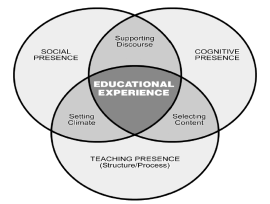 Part 1 in a 3 part series on the concept of ‘Presence’ in the Online Classroom.
Part 1 in a 3 part series on the concept of ‘Presence’ in the Online Classroom.
Instructor presence in the online environment can be elusive as a shadow – it’s one dimensional, monochromatic and takes on various forms depending upon the point of view. Yet, instructor presence in online learning communities is vital to ‘complete learning’ (by complete I mean student engages with content, applies higher order thinking skills, and produces tangible evidence that learning objectives are met). In the virtual environment the instructor needs to be ‘real’, 3 dimensional, have a personality, be the subject matter expert and as if this isn’t enough, help the student achieve the learning goals in this virtual space. A tall order. In this post I’ll share why and how instructor [virtual] presence is critical, essential instructional design components to facilitate presence, and strategies used by instructors that demonstrate presence.
 What is Online presence?
What is Online presence?
The concept of ‘presence’ in the online environment is in itself complex, involving thought, emotion and behaviours (Lehman and Conceicao, 2011). Presence in this context can be divided into categories of social, cognitive and instructor presence as presented in the Community of Inquiry model, which provides a framework for learning in the online environment (Garrison, 2003). An uncomplicated definition of online presence is, a sense of ‘being there’ or ‘being together with others’. For students to experience this sense of presence online, the technology must become transparent – the web enabled device, the platform, or site is invisible, in other words:
…the student becomes engaged by the content (whether people, text, images or other) and the technology disappears.
Why Instructor presence is Key to Learner Success…
Of course there are theoretical reasons which describe why the role of the instructor is crucial to online learning, but this week as I reviewed student feedback from our most recent session of online courses at my workplace, it became apparent just how important the instructor’s role is, by the level of ‘presence’ as perceived by the student. Below is a selection of student comments which illustrate the value of the instructor. Responses are to this question – “What did you like best about the course”:
Dr. ___ insight and instruction is outstanding. As a student who already holds a Master’s degree in Science, I appreciate a good instructor …
…The best thing about the course was Dr. ___. He really made things so that you could understand them…
Dr. ___ was very helpful, but at this point (the middle of week 8), he still has not uploaded grades for any of the course discussion boards, some of which I submitted 7 weeks ago….[this comment reinforces the value of instructor feedback]
A research study in Journal of Interactive Online Learning supports this observation. The study found that the largest single instructor action that students attributed to their success in the online course was the feedback provided by instructors that helped them [students] understand their strengths and weaknesses. The second most important success factor identified was the “instructor’s ability to focus discussions on relevant issues” (Kupczynsk et al., 2010).
Course Design to Support Instructor Presence
Another concept which is interesting is how the instructional design of the course itself supports ‘presence’. Course design can be considered, the silent instructor. When strong design principles are in place, this frees up the online instructor to invest time in connecting with students in the online community and teaching.
“The need for presentation of clear, concise objectives, instructions and general participation guidelines should be a cornerstone of online course development. Both groups in this study expressed significant frustration when these elements were not present and believed that successful engagement with content and activities was dependent on sound instructional design and organization”. (Kupczynsk, 2010).
 How the Instructor can establish presence
How the Instructor can establish presence
- The professor as a real person: Our instructors create a one to two minute welcome video. Students watch the clip during the first few days of the class. Instructors create a YouTube video clip (can be private), or create a .mov file on their laptop and upload the clip to our Learning Management platform. I love these clips – each are unique as the professor. Some are filmed in the instructor’s office, outside, or even in a coffee shop. These clips make the professor ‘real’ and set the tone for an open and interactive learning community.
- Communicating regularly: Posting a weekly announcement with course updates, web resources, commenting on course discussion boards and/or upcoming assignments also seems to be an effective method by the instructor communicating ‘en masse’. Using humour strategically can also break the ice and make the class fun, with a humourous YouTube clip or comic.
- Feedback on assignments. My absolutely favorite method of feedback that I received as a student, was when my professor recorded feedback on an assignment using the screen cast format, [Jing is one example]. The file was emailed (and posted in the gradebook). The instructor gave specific, personal commentary, and though it was only 3 or 4 minutes in length, it was effective. Another option is Audacity or Screencast.com.
- Feedback/input on Class Discussions. [Not surprising] research also suggests that students respond positively when instructors are involved in class discussions, rating this as a strong indicator of presence.
It takes a completely different skill set to instruct online than in the face-to-face environment. Hopefully this post provided some insight and assistance for those instructors teaching online. I’ll be covering social presence and cognitive presence in part 2 and 3 respectively. Click here for part II, Do we need Social Butterflies in Online Learning Communities?
Resources:
Lehman, R. & S.C.C. Conceicao. (2011). Creating a Sense of Presence in Online Teaching.
Jossy Bass Publishing. San Fransisco, CA.
Kupczynski, L., Ice, P., Wiesenmayer, R., & McCluskey, F. (2010). Student perceptions of the relationship between indicators of teaching presence and success in online courses. Journal of Interactive Online Learning, 9 (1).
Photo Credit: Professor: University of Maryland, Flickr
Pingback: Online Instructor Presence – Exploring Education
Pingback: Módulo 1 – Atividade 3 – Dicas e Estratégias | Curso sobre Presença Online
As I’ve been working in faculty development, I have found your statement “It takes a completely different skill set to instruct online than in the face-to-face environment” to be very true. Often times, instructors who teach f2f are told they will now need to teach online. However, in the hiring process and professional development process we don’t address the different skill sets and instead group it together and call it “teaching.”
LikeLike
Pingback: Instructor Presence in the Online Class – Key to Learner Success « SCC Learning Resources
Communication (#2) on a regualr basis is great. We do this in business, sports, our own families.
LikeLike
HI Bill. Absolutely right! Communication is critical to healthy relationships at work, home and school! Thanks for your comment. Debbie
LikeLike
Pingback: Instructor Presence in the Online Class – Key to Learner Success | online learning insights « 5ddigitalcomm's Blog
Pingback: Instructor Presence in the Online Class – Key to Learner Success | online learning insights | The eLearning Site